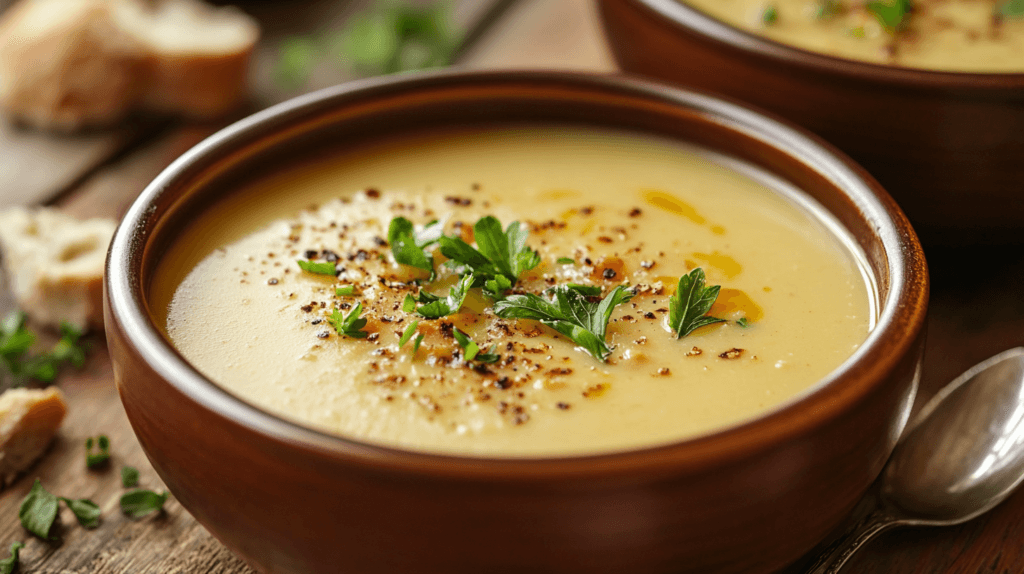Vegan Soup Recipe is one of my favourite recepices for perfect combination of health, flavor, and versatility. If you do care about your health and want to have a long life try to educate yourself by loving this recipe especially at dinner!
Whether you want something warm and hearty for winter or a refreshing bowl for summer, there’s a vegan soup for every occasion. Packed with vibrant vegetables, nourishing grains, and plant-based proteins, these soups provide a simple yet effective way to enjoy wholesome meals.
Table of Contents
Ingredients You’ll Need
Creating a vegan soup begins with selecting the right ingredients. Below is a breakdown of essential components, along with optional add-ins to enhance your soup’s flavor and texture.
Core Ingredients
- Broth Base:
Start with vegetable stock for a light, savory base. If you want a creamy texture, use coconut milk or blend a portion of the soup. - Seasonal Vegetables:
Include versatile options like carrots, celery, onions, potatoes, and leafy greens. Adding seasonal produce, such as squash in the fall or asparagus in the spring, enhances flavor and freshness. - Legumes and Beans:
Lentils, chickpeas, or black beans add protein and make your soup more filling. - Grains:
Quinoa, barley, and rice provide heartiness and improve the texture. - Herbs and Spices:
Use common options like thyme, cumin, paprika, and turmeric. Adding fresh herbs like parsley or cilantro just before serving can elevate the flavor.
Optional Add-Ins
- Nutritional Yeast:
A tablespoon or two adds a cheesy, savory taste. - Coconut Cream or Cashew Cream:
For rich, creamy soups, stir these in during the last few minutes of cooking. - Acidic Elements:
A splash of lemon juice or vinegar brightens the flavors and balances the richness.
By combining these ingredients, you can create a nourishing soup that is both simple and flavorful. To make your meal even more satisfying, pair it with the Cottage Cheese Flatbread Recipe, which adds texture and depth.

Step-by-Step Guide to Making Vegan Soup
1. Prepare Your Ingredients
First, ensure all your ingredients are ready. Wash and peel the vegetables, then chop them into even pieces to help them cook uniformly. Rinse legumes such as lentils or chickpeas under cold water to remove any debris. If you’re using grains like quinoa or rice, rinse them to remove excess starch.
2. Sauté Aromatics
In a large pot, heat two tablespoons of olive oil over medium heat. Once the oil is warm, add chopped onions, garlic, and celery. Stir them frequently, letting them cook for about five minutes until they become soft and fragrant. This step creates the flavor foundation for your soup.
3. Build the Base
Next, add your vegetables, such as carrots, potatoes, or zucchini. Stir them into the aromatic mixture, ensuring they are coated with oil and seasonings. Then, sprinkle in spices like cumin, paprika, or turmeric to deepen the flavor. Pour in vegetable broth or coconut milk, making sure the liquid fully covers the ingredients.
4. Add Proteins and Grains
For a hearty soup, stir in legumes like lentils, chickpeas, or black beans. If you prefer a thicker texture, add grains such as quinoa or barley. These ingredients not only make the soup more filling but also provide additional nutrients. Let the mixture simmer gently for 20–30 minutes, stirring occasionally to prevent sticking.
5. Simmer and Adjust
Once the vegetables and grains are tender, taste the soup and adjust the seasoning. Add a pinch of salt, a dash of pepper, or even a splash of lemon juice to enhance the flavors. For a smoother texture, blend part of the soup using an immersion blender. Alternatively, leave it chunky for a rustic presentation.
6. Serve and Garnish
Ladle the soup into bowls and garnish with fresh herbs, a drizzle of olive oil, or a sprinkle of nutritional yeast. For a complete meal, serve alongside warm bread or a side dish like Cheezy Rice.
Popular Vegan Soup Recipes
Here are some favorite vegan soup recipes to inspire you:
- Classic Tomato Basil Soup: A creamy blend of tomatoes, fresh basil, and cashews for richness.
- Hearty Lentil Soup: Packed with protein and fiber, this soup is perfect for a filling meal.
- Curried Butternut Squash Soup: Sweet, spicy, and velvety, it’s ideal for fall.
- Minestrone Soup: A medley of beans, pasta, and vegetables for a balanced dish.
- Potato Leek Soup: Smooth and creamy, with a hint of coconut milk for dairy-free comfort.
Tips for Perfect Vegan Soups
- Build Layers of Flavor:
Sautéing onions, garlic, and spices before adding liquid ensures a deep, robust taste. - Combine Textures:
Blend part of the soup for creaminess while leaving some chunks for a satisfying bite. - Use Fresh Ingredients:
Whenever possible, opt for fresh vegetables and herbs to maximize flavor and nutrients. - Add Acidity:
A splash of lemon juice or vinegar at the end brightens the overall taste. - Store Smartly:
Cool your soup completely before refrigerating. Store in airtight containers for up to five days, or freeze for three months.
Seasonal Variations for Vegan Soups
One of the best aspects of vegan soups is their adaptability to seasonal ingredients, allowing you to enjoy fresh flavors throughout the year. By using vegetables and herbs that are in season, you can create soups that are not only flavorful but also packed with nutrients. Seasonal produce ensures peak freshness, and incorporating these ingredients can also be cost-effective.
Spring
Spring is the perfect time to enjoy light and vibrant soups that reflect the season’s renewal. Make a fresh asparagus and pea soup, garnished with mint for a refreshing and aromatic touch. Add a squeeze of lemon juice to brighten the flavors further. This soup is ideal for cooler spring evenings when you crave something warm but not too heavy.
Summer
In the heat of summer, chilled soups are a fantastic way to stay cool while still enjoying the benefits of a nutrient-rich meal. A classic gazpacho made with fresh tomatoes, cucumbers, and peppers is both hydrating and delicious. For a lighter option, try a cucumber and dill soup, blended with plant-based yogurt for a creamy texture. These cold soups are perfect for picnics or al fresco dining.
Fall
As temperatures drop, fall brings an array of comforting options. Roasted pumpkin or butternut squash soup with warm spices like cinnamon, nutmeg, and ginger is a seasonal favorite. These creamy soups pair wonderfully with crusty bread or a side salad. Adding a splash of coconut milk enhances the richness while maintaining the plant-based profile.
Winter
Winter is all about hearty, warming stews that nourish and satisfy. Root vegetables like sweet potatoes, carrots, and parsnips shine in winter soups, combined with lentils, barley, or beans for extra substance. Spices like cumin and smoked paprika add depth and heat, making these stews a cozy meal for chilly evenings.
Eating seasonally also ensures you get the maximum nutritional benefits from your produce. For more guidance on making healthy choices and understanding seasonal food safety, explore the FDA’s guide on food safety and nutrition. These tips will help you create wholesome and delicious vegan soups year-round!

FAQs About Vegan Soups
Can I freeze vegan soups?
Yes! Vegan soups freeze exceptionally well, making them a perfect option for meal prep. Store your soup in freezer-safe, airtight containers or resealable freezer bags to prevent freezer burn. Soups can be frozen for up to three months. To reheat, thaw overnight in the refrigerator and warm on the stovetop over low heat. Add a splash of vegetable broth or water if the soup has thickened during freezing.
How do I make creamy vegan soups?
To achieve a creamy texture in vegan soups without dairy, use plant-based alternatives like coconut cream, cashew cream, or blended silken tofu. Another option is to blend part of the soup using an immersion blender, which thickens the broth naturally by breaking down some of the vegetables and grains. Nutritional yeast also adds a cheesy flavor and smoothness to your soup.
What are the best protein sources for vegan soups?
Legumes such as lentils, chickpeas, and black beans are fantastic sources of plant-based protein. Grains like quinoa, farro, and barley also provide a protein boost along with essential nutrients. Additionally, tofu or tempeh can be added for extra protein and texture.
What can I serve with vegan soup?
Vegan soups pair beautifully with a variety of sides. Crusty whole-grain bread is a classic choice, while rice, quinoa, or flatbreads can make the meal more filling. For an indulgent touch, consider serving your soup with Cheezy Rice or Cottage Cheese Flatbread.
What is the healthiest soup you can eat?
The healthiest soups are those made with nutrient-dense, plant-based ingredients. Look for soups packed with leafy greens, colorful vegetables, legumes, and whole grains. Broth-based soups, such as lentil vegetable soup or minestrone, tend to be lower in calories while providing essential vitamins, minerals, and fiber. Avoid heavy creams and high-sodium broths for the healthiest results.
Are any canned soups vegan?
Yes, many canned soups are vegan. However, always check the label to ensure there are no animal-derived ingredients such as dairy, meat broth, or gelatin. Brands like Amy’s Kitchen, Pacific Foods, and Campbell’s Well Yes! offer a variety of vegan-friendly canned soups. Opt for low-sodium options when possible to keep your soup healthy.
What can I use instead of dairy in soup?
There are numerous plant-based alternatives to dairy for making creamy soups. Coconut milk, almond milk, and oat milk are great liquid substitutes. For richer textures, try blending cashews, silken tofu, or potatoes into the soup. Nutritional yeast and vegan cheese are also excellent for adding flavor and creaminess.
Is Panera veggie soup vegan?
Panera Bread offers several vegetarian soups, but not all are vegan. For example, their Ten Vegetable Soup is vegan-friendly and made with a mix of bell peppers, tomatoes, and grains in a spiced broth. Always check Panera’s allergen information or ask staff to confirm the soup’s ingredients before ordering.
By answering these common questions, you’ll feel more confident making, choosing, and enjoying vegan soups that are both healthy and delicious.
Conclusion
Vegan soups are the ultimate comfort food, offering a delicious way to enjoy healthy, plant-based meals. Their flexibility and ease of preparation make them perfect for beginners and seasoned cooks alike. Whether you’re blending a creamy tomato soup or simmering a hearty lentil stew, these soups bring nourishment and warmth to your table.
Start experimenting with seasonal ingredients and creative flavors to make your vegan soup unique. For more ideas, explore the health benefits of lentils and enjoy the endless possibilities of vegan soups!

